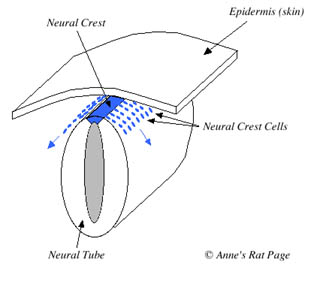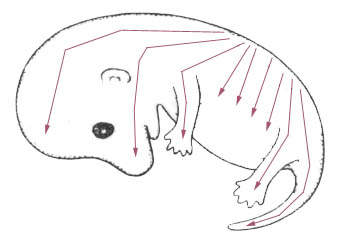Why do some rats have white blazes and megacolon?
Some rats, especially rats with white blazed faces, white sides, or odd-eyes, develop a fatal condition called megacolon. Rats with megacolon cannot pass feces. Over time, the feces back up in the colon, distending the belly and ultimately causing death. Megacolon is found in humans too, where it is called Hirschprung's disease.
A frequently asked question is why megacolon in rats appears to be associated with patches of white pigment. I did a bit of reading on the subject and have found out why. It has to do with a common develomental pathway going awry.
In the embryo, neural cells originate in a strip along the back (called the neural crest) and migrate from there to the rest of the body during development (fig. 1). Pigment cells are actually a subset of these neural cells. Lots of neural cells do this migration, such as the ones that ennervate the colon, and ones that go into the inner ear.

Fig 1. Neural crest cell migration from neural tube.

Fig 2. Migration of pigment cells from neural crest in the rat embryo after 18 days (adapted from Wendt-Wagener 1961)
If this cell migration is delayed, then these cells may not reach their destination. So, you can end up with depigmented (white) areas on the body, particularly the areas far away from the back, such as the face, irises, feet, belly, tail tip and so forth (fig. 2) though the depigmentation can be widespread too.
A delay in migration of the neural cells means that the end of the colon may not get ennervated, which means the animal cannot control the colon properly, resulting in megacolon.
Neural crest cells also migrate into the inner ear, where they are important for hearing. This is why a mutation in cell migration can sometimes result in white splotches and deafness (e.g. in cats and dogs).
Cell migration is a complex process with many steps, and there are many different ways it can go wrong. For example, migrating cells follow molecular "signposts" which tell them where to go in the body. A mutation in these signposts, or in the migrating cells' receptors which are supposed to "read" these signposts, can affect migration.
Rats aren't the only animals with mutations in cell migration resulting in white pigment and colon and hearing problems. Many other animals have these mutations too, and each mutation results in a different constellation of related symptoms... from blazed rats or odd-eyed rats with megacolon, to white foals with megacolon (called lethal white foal syndrome), to humans with a white forelock, odd-eyes, deafness, and megacolon (called Waardenburg Type 4 or Waardenburg-Shah Syndrome), to white-faced deaf ferrets (also called Waardenburg), to dogs and cats with a white coat and deafness (like many dalmatians). All are mutations in the process of cell migration from the neural crest during embryogenesis.
The mutations found in these different species may not be the identical mutation, and the same species may have different kinds of mutations that affect this developmental pathway, but they all affect the same, common, underlying process.
Note, however, that megacolon may be caused by other factors (e.g. Lipman et al. 1998). Not all blazed rats have megacolon, and megacolon can be found in non-blazed rats as well.
If you enjoyed this piece and would like to know more, here's more depth on mutations in pigment cell migration.